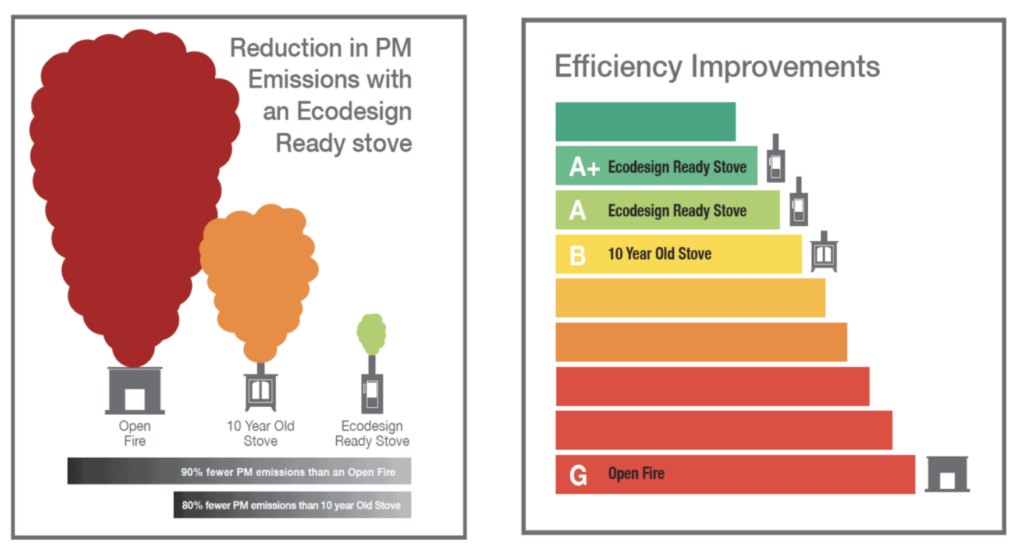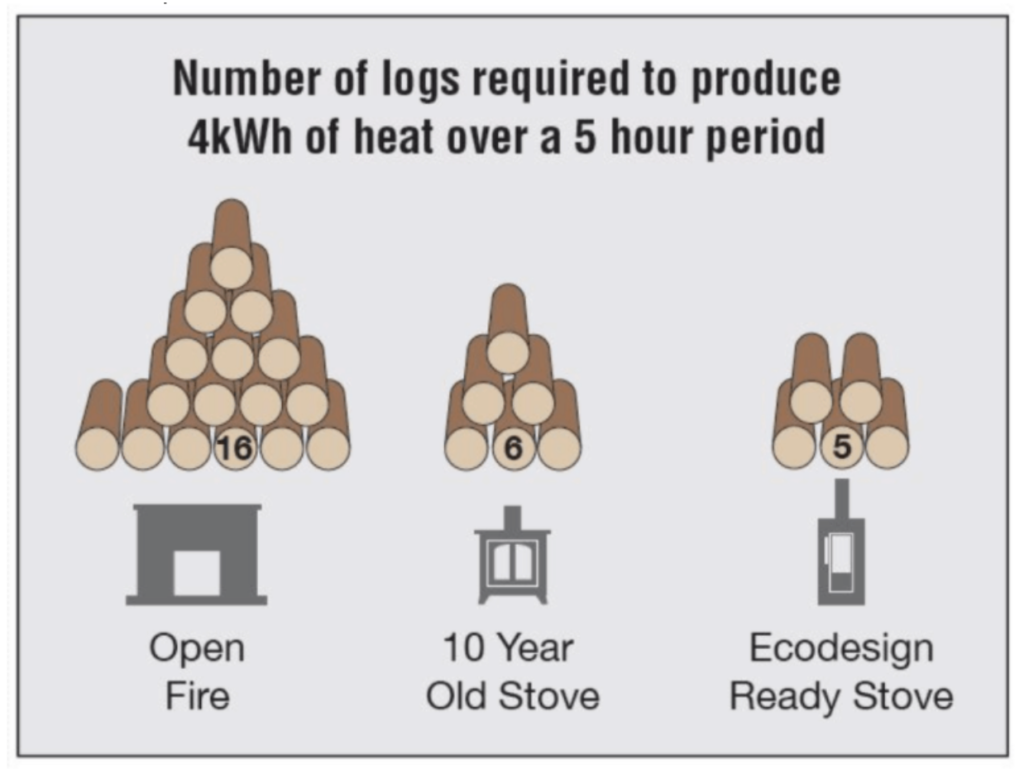As we progress further into autumn, more people are starting to switch their heating on and lighting their wood-burning stoves. One thing you should be mindful of if you burn wood is how efficient you are being. It’s incredibly important that you always burn wood in the most efficient way possible. There is a significant difference in emissions emitted from an open fire compared to that of an Ecodesign wood-burning stove. The diagram below demonstrates just how much:

Lowering emissions from burning wood, or any other similar activity for that matter, will help reduce your overall carbon footprint, which is key in helping drive down the dramatic impact of global climate change.
There are a number of elements and gases which are released when we burn wood. Wood is made from cellulose, hemicellulose, lignin, trace quantities of inorganic elements and water. Cellulose and lignin are mainly created from carbon, oxygen and hydrogen. Like with other carbon-based fuels, when we burn wood, the main emissions are water vapour and, the problem child – carbon dioxide!
Carbon Dioxide (CO2) – This is a greenhouse gas, which means it contributes to global warming. Without these greenhouse gases, the world’s temperature would be too low to sustain life – so they are not inherently bad. However, since the Industrial Revolution, carbon dioxide has been released into the atmosphere in excess by human activity, such as the burning of coal, which has inadvertently increased the earth’s temperature to problematic levels.
Carbon Monoxide (CO) – Is regarded as a pollutant and is an odour and colourless gas. In large enough qualities, it can be deadly, which is why a Carbon Monoxide detector is recommended in almost all homes. It is formed when combustion is incomplete. So, a poorly serviced or faulty heating appliance which is unable to give a complete combustion can pose a serious health risk. A weak orange or yellow flame, condensation on the inside of windows and soot around a gas appliance are all warning signs to be aware of.
Particulate Matter (PM) – Particulate matter is a product of incomplete combustion and is mainly ash, solid carbon, and condensed liquid carbon compounds. PM10 relates to matter, which is 10 millionth of a meter across. PM 2.5 is 2.5 millionth of a metre across. PM is small enough to penetrate deep into the body and cause significant issues such as heart disease, respiratory issues and much more.
Nitrogen Oxides (NOx) – This consists of two odours and colourless gases, Nitric Oxide and Nitrogen Dioxide. These are formed from nitrogen in the air and also from small quantities of fuel. Nitrogen Oxides are considered a pollutant.
Organic Gaseous Compounds (OGC) – Are a group of compounds which, like Carbon Monoxide, are emitted as a result of an incomplete combustion. When they cool and condense, they contribute to PM emissions in the air.
So what does all this mean?
Unless you’re a scientist or have a specific interest in this area, you may have never heard much about the elements above, or how they all play their part in creating emissions. But having an awareness of these and the impact they have when you burn wood can only be a good thing. When we create an Ecodesign stove, there is a huge amount of development which has been invested to make sure that when wood is burned on a stove, the flame and corresponding heat output is as efficient as possible.
Ecodesign vs Open Fire
By referring to the points above, it’s easy to see the problems that come with an inefficient burn. Open fires are incredibly inefficient, compared to an Ecodesign stove, as they draw room heat into the fire, which then disappears up the chimney. So, you then need to burn more wood for the same desired level of warmth – at the same time, the wood you are burning is subject to a much less efficient burn, compared to the Ecodesign stove. So, it’s essentially a double whammy. The diagram below demonstrates the differences between an Ecodesign stove and an open fire:

There are a lot of developments and technological advancements showcased in an Ecodesign stove. It is important that people are made aware of this. More should be done to highlight and educate consumers as to the advantages of using an Ecodesign stove and making a move away from an open fire if they wish to keep warm in a greener, cleaner more efficient way.








